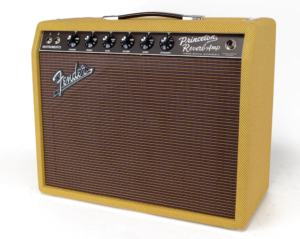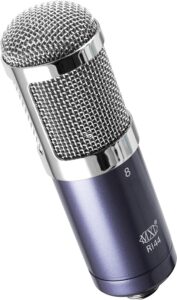 The Fender clean tone is one of the classics. It makes complete sense that Fender would reissue new versions of the old amps, like the Princeton and Deluxe Reverbs. I chased that tone for a long time and found it in a Deluxe Reverb Reissue, sometimes abbreviated as a DRRI in online conversation.
The Fender clean tone is one of the classics. It makes complete sense that Fender would reissue new versions of the old amps, like the Princeton and Deluxe Reverbs. I chased that tone for a long time and found it in a Deluxe Reverb Reissue, sometimes abbreviated as a DRRI in online conversation.
When I bought my PRS Ted McCarty SC245, I tried it out on an Egnater Tweaker combo amp and decided that it’s Fender voicing was “close enough”. I stuck with that for almost a decade before buying another Fender.
This time, instead of a DRRI, I bought a Princeton Reverb, it’s 15w little brother. Normally, a Princeton Reverb have a 10″ speaker and a smaller cabinet to math. People have mixed opinion of the 10″, with some saying it sounds to boxy and small. When I stumbled upon the model you see above on Sweetwater’s site, I was immediately interested. That model came with a 12″ Eminence Cannabis Rex.
While 15 Watts isn’t all that much quieter than the 22 watts of the DRRI, but it has less “headroom”, which is to say the sound starts to dirty up sooner. At this point, we lived in a house and I could crank the amp when the family was away.
Did I mention that 15 watts is really loud?
 Without hesitation, the short answer is “Yes, absolutely 100%!”
Without hesitation, the short answer is “Yes, absolutely 100%!”
The long answer is that vintage amps are getting to be more and more expensive. They are currently priced out of the range I want to pay. Perhaps I will one day own one.
One of the biggest reasons is that modern amps, including the Fender reissues, are built with printed circuit boards, or PCBs. When something goes on a PCB, it can be an expensive repair. This makes them cheaper in the short run.
Vintage amps, and some higher end modern ones, are built “point to point” with each individual component being wired in line. When one component goes bad, you replace that component. Some might argue it’s cheaper in the long run.
A few years ago I became attached to the idea of owning a Les Paul or Fender guitar from my birth year. Within the year of that idea, I ended up buying a Fender Vibro Champ that a local amp tech confirmed, independently of knowing my desire, that it was indeed from that exact year.
The Vibro Champ has left my collection and, for the time being, satisfied that desire. Don’t get me wrong, if the right opportunity came around to own a 1978 Fender Telecaster or Les Paul, I’d probably try to make that happen. Same goes for the amp. While the reverb and tremolo of my Princeton Reverb are nice, there’s something special about the vintage versions.
It’s a matter of cost and I think that’s what will be the deciding factor. Unless thousands of people discover and start listening to a lot of KCWM music, the continuing rise in value of vintage amps and guitars will be the hurdle I have to overcome.
 This has changed over time as I started recording music for release back in 2018.
This has changed over time as I started recording music for release back in 2018.
For Low-Fi, Nice Try’s Waiting Drove Us Mad EP I used a Sennheiser e609 to mic the Princeton Reverb on “Juilliard” and “Ghost”.
For Cold the Winter’s Skylines and the Horizon EP I used a Sennheiser e609 coupled with an MXL R144. I replaced the e609 with a Sennheiser e906 around Christmas of 2018. and used the e906 on a couple of tracks for that EP.
 For KCWM Volume One and Volume Two, I used the Sennheiser e906 and MXL R144.
For KCWM Volume One and Volume Two, I used the Sennheiser e906 and MXL R144.
The R144 was a great introduction into the world of ribbon mics, but I wanted to upgrade.
 Somewhere in the middle of Volume Three, I swapped out the MXL R144 for a Royer R10 and that’s where I currently stand, mic-wise.
Somewhere in the middle of Volume Three, I swapped out the MXL R144 for a Royer R10 and that’s where I currently stand, mic-wise.
The R10 is positioned on the left side of the Princeton’s speaker and the e906 is on the right, and both often serve as the primary focus of most guitar tracks I record. Both mics are run into a Cloudlifter CL-2 before the audio interface.
This pairing has stayed in place as I’ve recorded singles post Volume Three and will continue to do so for the foreseeable future.
I have been thoroughly satisfied with the purchase of my Princeton Reverb. At the time, it didn’t break the bank, the tremolo and reverb on it are excellent, and it has been a consistent performer.
I’d definitely suggest it, though it would depend on the circumstances.
• Do you play with a loud drummer? The 15w might not be enough to get clean tones at practice levels unless you’re plugging into a PA.
• If you play with a drummer that doesn’t pound the crap out of their set, then it might work, especially elevated at ear level.
• If you have a small bedroom studio, especially if you use a drum plugin like I do, it’s a great amp.
Regardless of the circumstances, you’re going to want to throw pedals at it. If you’re going for natural breakup, a drive pedal will goose a little more juice out of it. If you want to toss in a Marshall-in-a-box pedal, like my Zvex Double Rock, you could kind of have your cake and eat it too.
In a world of noise, be sound.
